Telesfor Wincenty Chodkowski married Paulina Kobylińska on 12 January 1888 in Płoniawy.
Telesfor’s name was shown as “Telesfor Wincenty (two names) Chodkowski, a.k.a. Kołakowski, whom Izabel Kolakowska confirmed”. He was 31 years old, born in the village of Las (Szelków parish), son of Remigiusz and Franciszka née Kołakowska Chodkowski.
Paulina Kobylińska was 24 years old, born in the village of Bobino Wielkie (Przasnysz parish), daughter of Teodor and Marianna née Chodkowska Kobyliński.

Marriage of Telesfor Wincenty Chodkowski and Paulina Kobylińska – 1888
In Russian, this document states:
Бобино Вельке
23.
Состоялосъ въ деревне Плонявахъ, тридцать перваго Январ (двенадцатаго Февраля) Тысяча восемьсотъ восемьдесятъ восмаго года, въ три часа по полудни. Объявляемъ что въ присутствии овидетсгей Юзефа Чаплицкаго сорока летъ, Якуба Политовскаго пятьдесяти летъ отъ роду, обоихъ част бладеьцевъ жительствующихъ въ деревне Бобино-Вельке, заключепо сего числа религиозный брачный союзъ между. Телесфоримъ Викентисиъ двухъ именъ Ходковскимъ, онъ же, Колаковскии которого Изабеля Колаковская уеановлела, а которой актъ уеановления, согеласно закона въ копии предявлнъ къ сепу акту выданъ Администраторимъ Шельковскаго Прихода, отъ восемьнадцатаго (мридцатаго) Января сего года, за номеромъ пятымъ, тридцати одного года, холостылмъ объездчикоиъ Казеннахъ Лесовъ въ деревне Липа Праснымскаго Уезда, урозенцеле селения Лась Шельковскаго Лрихода, Маковскаго Уезда, сыномъ Ремигиуша и Францишки урожденной Колаковской супруговъ Ходковскихъ, пеиющинъ жительство въ деревне Липа, и паулиного Кобылинского девицею родившеюся въ селении Бобино-Вельке, дочерью Теодора и Мариянна урожденной Ходковской, супруговъ Кобылинскихъ, частныхъ впадельцевъ жительствующихъ въ деревне Бобино-Вельке, двадцати четирехъ летъ, жительствующего при родиинеляхъ, – Браку сему предшествовали три огпашения опубликлованные въ Праснышскииъ Приходскихь Костелахъ въ Воскресныь дни, а лменно, семьнадцатаго, двадцать четвертаго, и тридцать перваго Января (двадцать девятаго Января, пятаго и двенадцатаго Февраля) текущаго года. Новобрачные объявляютъ что опи предбрачнаго договора не заключиен. Религиозный обрядъ бракосочетания совершенъ Ксендзомъ Эдуардоиъ Гуто вскииъ Плонявскииъ Администраторомъ. Актъ сей Новобрачнымъ и свидетелямъ прочитанъ Нами и Новобрачными подписанъ, свидетелям неграмотние. – Кс. Эд. Гитовскии плонявскии Администраторъ Содержащий Акты Граж[данскаго] Сост[ояния]
T. W. Chodkowski vel Kołakowski
P. Kobylińska
Translated into English, the document states:
Bobino Wielkie
23.
This took place in the village of Płoniawy on 31 January [Julian calendar] / 12 February [Gregorian calendar] 1888, at 3 o’clock in the afternoon. We declare that in the presence of Joseph Czaplicki, 40 years old, and Jakub Politowski, 50 years old, both of whose parents live in the village of Bobino Wielkie, a religious marriage union was concluded on this day between Telesfor Wincenty (two names) Chodkowski, a.k.a. Kołakowski, whom Izabela Kolakowska confirmed and a copy of whose act of confirmation issued by the Administrator of Szelków Parish on the 18th [Julian calendar] / 30th [Gregorian calendar] of January of this year, number 5, is attached to this record in accordance with the law, 31 years old, unmarried, the ranger of the State Forests in the village of Lipa, Przasnysz Powiat, born in the village of Łaś, Szelków parish, Maków Powiat, son of the married couple Remigiusz and Franciszka née Kołakowska Chodkowski who resided in the village of Lipa, and Paulina Kobylińska, a maiden born in the village of Bobino-Wielkie, daughter of the married couple Teodor and Marianna née Chodkowska Kobyliński, private owners living in the village of Bobino-Wielkie, 24 years old, living with her parents, – This marriage was preceded by three declarations published in the Przasnysz Parish Church on Sundays, namely, the 17th, 24th, and 31st of January [Julian calendar] / 29 January, 5th and 12th of February [Gregorian calendar] of the current year. The newlyweds declare that no prenuptial agreement has been concluded. The religious ceremony of marriage was performed by Father Edward Gutowski, Administrator of Płoniawy. This document was read to the newlyweds and witnesses by us and signed by the newlyweds. The witnesses are illiterate. – Reverend Ed[ward] Gutowski, Administrator of Płoniawy, Maintaining the Records of the Civil State
[signed] T. W. Chodkowski a.k.a. Kołakowski
[signed] P. Kobylińska
It’s not clear why Telesfor’s name is listed as Telesfor Wincenty Chodkowski a.k.a. Kołakowski, or who Izabela Kołakowski is. What is clear, is that there is some legal connection between Telesfor and Izabela.
Copyright © 2025 by Stephen J. Danko













